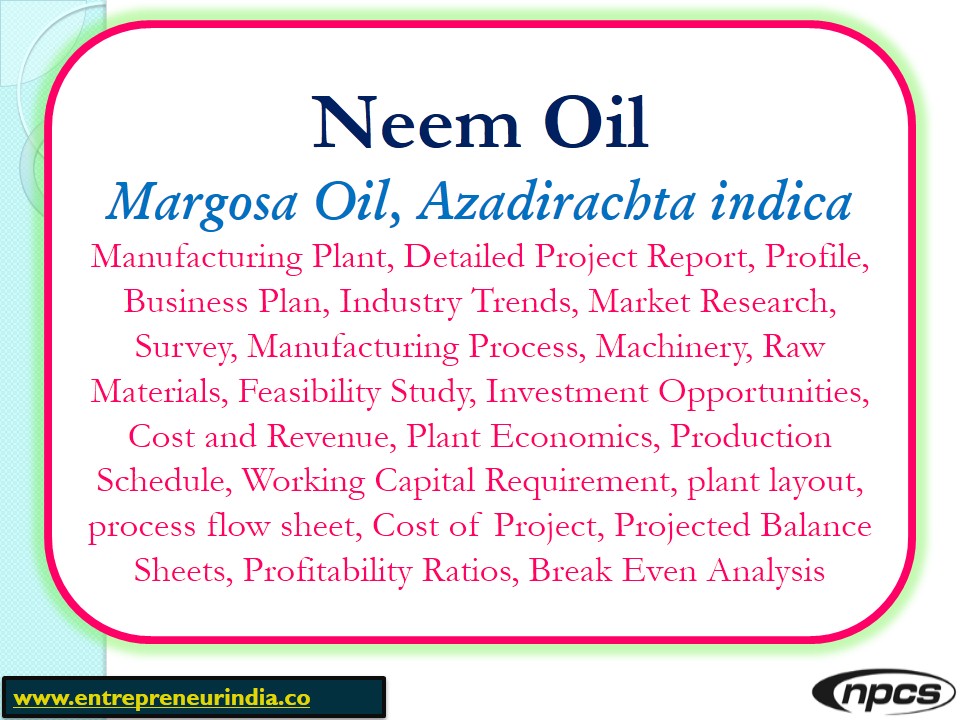
Neem oil manufacturing has been recognized as a lucrative and eco-friendly business venture. Due to its wide range of applications in agriculture, medicine, cosmetics, and pest control, neem oil enjoys a stable and growing demand in both domestic and international markets. In India, neem (Azadirachta indica) is abundantly available, and thus raw materials can be sourced easily. Consequently, a neem oil manufacturing plant can be established with moderate capital investment, provided the right processes and strategies are adopted.
Introduction to Neem Oil Manufacturing
Neem oil is a natural, non-toxic product extracted from neem seeds. Traditionally, the oil has been used for its antifungal, antibacterial, and pesticidal properties. Over time, scientific validation of its benefits has significantly increased its commercial importance. Because of its compatibility with organic farming and herbal products, neem oil has been included in various health, agricultural, and cosmetic formulations. Therefore, a consistent and efficient manufacturing setup is crucial for meeting quality standards and market demands.
See Also – Medical College with Hospital Project
Market Potential and Applications
Neem oil manufacturing has been encouraged by the growing demand for natural and sustainable products. In recent years, neem-based pesticides have gained acceptance as safer alternatives to synthetic chemicals. Moreover, neem oil is being incorporated in cosmetics, soaps, lotions, medicinal ointments, hair oils, and even oral care products.
Additionally, neem oil has been accepted as a biopesticide under the Integrated Pest Management (IPM) programs globally. As a result, demand from organic agriculture is steadily rising. With the support of export incentives and government schemes for herbal and eco-friendly product manufacturing, the neem oil business is being promoted across India and other neem-growing countries.
Setup and Infrastructure Requirements
To begin neem oil manufacturing, a systematic setup is required. The facility must be established in an area where neem seeds are available in abundance. Typically, rural and semi-urban locations are preferred due to the proximity to raw materials and reduced operational costs.
The following units are essential:
-
Seed cleaning and drying area
-
Oil extraction and filtration section
-
Storage tanks for crude and filtered oil
-
Packaging unit
-
Quality control lab (optional but recommended)
Basic utilities such as electricity, water supply, and proper drainage must be ensured. Moreover, adequate ventilation and hygiene are essential, particularly if the oil is intended for medicinal or cosmetic use.
Raw Material and Procurement
For neem oil manufacturing, the most critical raw material is neem seed kernels. These kernels should be collected after the fruits have matured and fallen from the trees. Once collected, seeds must be dried under shade and stored in dry conditions to prevent fungal contamination.
Although seed availability is seasonal, it can be ensured year-round by contracting with local farmers or suppliers. Bulk storage of seeds in moisture-controlled environments is advised.
Manufacturing Process of Neem Oil
The neem oil manufacturing process typically follows either cold pressing or solvent extraction methods. While both are viable, cold pressing is preferred for high-quality, organic-grade oil.
Step-by-Step Manufacturing Process
-
Seed Cleaning & Drying
Initially, collected seeds are cleaned to remove dust, husk, and foreign particles. Sun-drying is preferred to reduce moisture content to around 8–10%. -
Kernels Decortication
Seeds are broken to separate the kernels from the shells. The oil content resides primarily in the kernels. -
Grinding
Kernels are ground into a coarse powder to facilitate better oil extraction. -
Cold Pressing or Solvent Extraction
-
In cold pressing, mechanical expellers are used to extract oil without applying heat. This preserves the active compounds like azadirachtin.
-
In solvent extraction, hexane or other food-grade solvents are used to extract oil, which is then distilled to remove residues.
-
-
Filtration
The crude oil is filtered to remove suspended solids, gums, and impurities. -
Storage & Packaging
Filtered neem oil is stored in stainless steel tanks and then packed in plastic or glass bottles, cans, or barrels depending on market requirements.
Throughout the process, care must be taken to maintain the oil’s natural composition. Additionally, modern filtration and storage techniques should be applied to avoid rancidity.
Machinery and Equipment Required
Depending on the capacity of the plant, the following machinery is required:
-
Seed cleaners
-
Decorticators
-
Grinders
-
Oil expellers or solvent extractors
-
Filter presses
-
Storage tanks
-
Packaging machines
Moreover, a laboratory setup may be included for quality assurance and batch testing. Machinery should be sourced from reputed manufacturers who offer support and spare parts availability.
Quality Standards and Licensing
Since neem oil is used in agriculture, cosmetics, and healthcare industries, adherence to quality standards is crucial. For organic certification, inspections and accreditations by authorized bodies are mandatory.
Additionally, the following licenses may be required:
-
Factory license from local authorities
-
MSME registration
-
Pollution control clearance
-
FSSAI license (if oil is sold for human application)
-
Drug license (for medicinal formulations)
-
Export license (for international markets)
Compliance with BIS (Bureau of Indian Standards) and specifications such as IS 11499 for neem-based pesticides should also be ensured.
Financial Aspects and Project Cost
A medium-scale neem oil manufacturing plant can be established with an estimated investment ranging from ?25 lakhs to ?50 lakhs. This includes:
-
Land and building (owned or rented)
-
Machinery and installation
-
Raw material procurement
-
Labor and operational cost
-
Licensing and marketing expenses
Working capital should be estimated for at least 3 to 6 months. Moreover, term loans and subsidies can be availed under agricultural and MSME schemes. Assistance from NABARD, KVIC, and SIDBI has also been offered to eligible entrepreneurs.
Manpower and Skilled Staff
For smooth operation, the following workforce is generally required:
-
Plant manager
-
Machine operators
-
Skilled technicians
-
Packaging staff
-
Administrative and sales personnel
Training on seed selection, oil extraction, and quality testing must be provided. Additionally, hygiene and safety protocols should be followed to maintain product integrity.
Marketing and Distribution Strategy
Once production has been established, focus must be shifted to branding and market penetration. Since neem oil is widely used across industries, segmentation is essential. The product may be offered in bulk for agriculture or pharma use, while smaller packaging should be done for cosmetics and home-use products.
Offline marketing through dealers, agri-input shops, and cosmetic distributors can be adopted. Simultaneously, online platforms, marketplaces like Amazon or Flipkart, and export channels should be tapped. Participation in trade expos, agro fairs, and herbal product exhibitions can also yield good leads.
Furthermore, labeling should highlight product purity, cold pressing (if applicable), organic certification, and usage guidelines to enhance customer trust.
Challenges and Risk Management
While neem oil manufacturing offers strong returns, certain challenges must be addressed:
-
Seasonal seed availability
-
Competition from synthetic pesticides
-
Price volatility of raw material
-
Quality assurance during storage
-
Need for certifications in export markets
To mitigate these risks, backward integration with neem seed suppliers or farmers should be planned. Contract farming and storage infrastructure must be developed for long-term stability.
See Also – Beekeeping & Honey Processing
Conclusion
In conclusion, neem oil manufacturing has emerged as a viable and sustainable industrial opportunity. Not only is the process environmentally friendly, but also the end product finds extensive use across sectors. With rising awareness about natural and herbal products, demand for neem oil has been significantly boosted.
By establishing a neem oil manufacturing plant with the right process, equipment, and market strategies, consistent revenue and growth can be achieved. Furthermore, since neem is indigenous to India and widely available, the venture is ideally suited for local entrepreneurs and MSME units.





